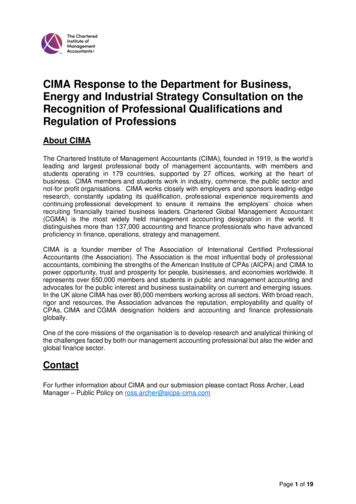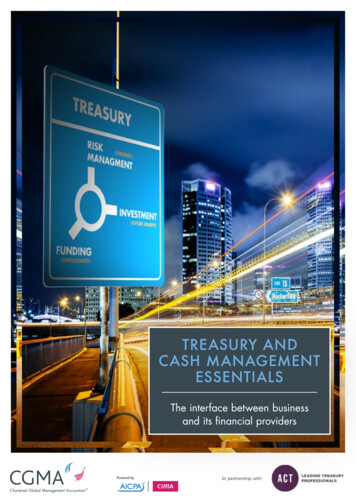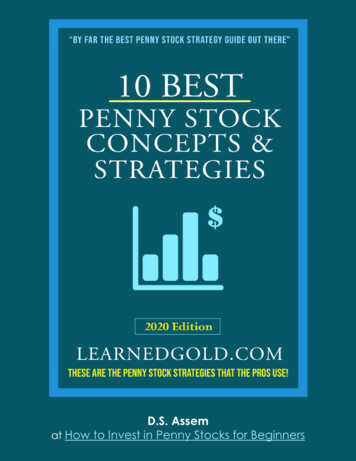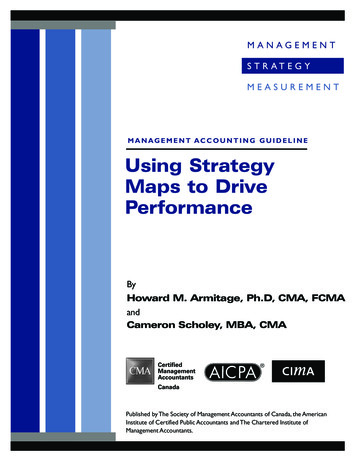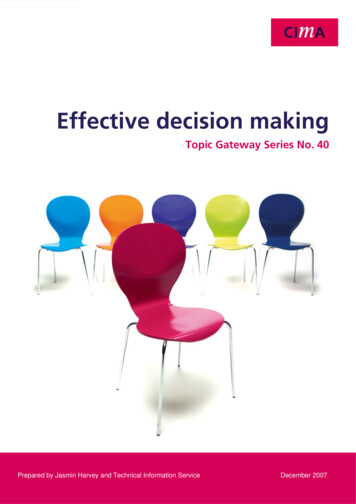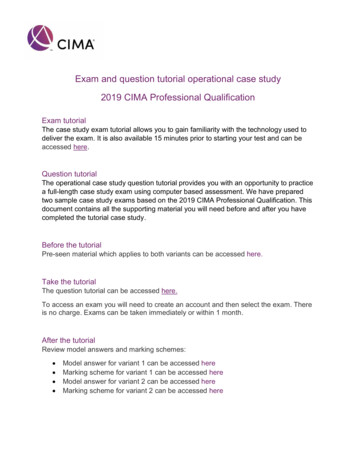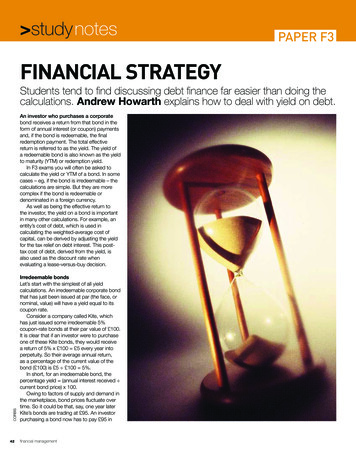
Transcription
studynotesPAPER F3Financial StrategyStudents tend to find discussing debt finance far easier than doing thecalculations. Andrew Howarth explains how to deal with yield on debt.CORBISAn investor who purchases a corporatebond receives a return from that bond in theform of annual interest (or coupon) paymentsand, if the bond is redeemable, the finalredemption payment. The total effectivereturn is referred to as the yield. The yield ofa redeemable bond is also known as the yieldto maturity (YTM) or redemption yield.In F3 exams you will often be asked tocalculate the yield or YTM of a bond. In somecases – eg, if the bond is irredeemable – thecalculations are simple. But they are morecomplex if the bond is redeemable ordenominated in a foreign currency.As well as being the effective return tothe investor, the yield on a bond is importantin many other calculations. For example, anentity’s cost of debt, which is used incalculating the weighted-average cost ofcapital, can be derived by adjusting the yieldfor the tax relief on debt interest. This posttax cost of debt, derived from the yield, isalso used as the discount rate whenevaluating a lease-versus-buy decision.42Irredeemable bondsLet’s start with the simplest of all yieldcalculations. An irredeemable corporate bondthat has just been issued at par (the face, ornominal, value) will have a yield equal to itscoupon rate.Consider a company called Kite, whichhas just issued some irredeemable 5%coupon-rate bonds at their par value of 100.It is clear that if an investor were to purchaseone of these Kite bonds, they would receivea return of 5% x 100 5 every year intoperpetuity. So their average annual return,as a percentage of the current value of thebond ( 100) is 5 100 5%.In short, for an irredeemable bond, thepercentage yield (annual interest received current bond price) x 100.Owing to factors of supply and demand inthe marketplace, bond prices fluctuate overtime. So it could be that, say, one year laterKite’s bonds are trading at 95. An investorpurchasing a bond now has to pay 95 infinancial management
CIMA Executive CPD Academy7–8 October 2010 LondonA two day academy providing high level professional CPD trainingto senior executives. It will cover seven strategic areas, all key toyour career and help you fulfil your annual CPD requirements.Book by 6 September to get the early booker rate of 1495 ( VAT).For more information and to book:E. conferences@cimaglobal.comT. 44 (0)845 026 4722www.cimaglobal.com/executiveChoose confidentlyThere’s countless reasons to choose LSBF as your businessand finance education provider. here’s 3:1. Financial times2. number 1 for online3. PQ magazineThe LSBF MBA is listed at number19 in the 2010 Global Financial TimesOnline MBA programmes listing.LSBF won PQ Magazine’s numberone online learning platform and PassMagazine’s best website of 2009.LSBF is the only college to win PQMagazine’s College of the year, twoyears in a row. LSBF CIMA tutorJenny Hughes is PQ Magazine’s2010 tutor of the year.Find out how to win a Mini Cooper*by visiting LSBF.org.uk/winmini*See website for details. Terms and conditions apply. E&OE.LondonBirminghammancheSterintera ctiveLSBF.org.uk0207 823 2303FBT-Global.com0121 616 3370LSBF.org.uk/Manchester0161 713 1777StudyInterActive.org0207 099 0077
studynotesPAPER F31 Calculating the internal rates of return for Kite’s redeemable bondTime Discount factors at adiscount rate of 8%Year 0(100)1.000Years 1-513.993Year 51500.681order to receive the intereststream of 5% x 100 5every year intoperpetuity. Theinterest is alwayscalculated byapplying thecoupon rate to thebond’s par value,irrespective of its currentprice. So the yield in this caseis ( 5 95) x 100 5.26%.It’s notable that bond prices andbond yields are inversely related – ie,the lower the price of a bond, the higher itsyield will be. This is because the actualamount of interest (coupon amount) staysconstant. So, if the bond’s price falls, theinterest represents a higher proportion ofthe price.Redeemable bondsThe yield on a redeemable bond – ie, onewith a specified maturity or redemptiondate – is a more complex calculation,because the redemption amountand the remaining time beforematurity will also influence the yield.To see why, consider the followingsimple example.Assume that Kite is about toissue some more 100 bonds at par,this time with a coupon rate of 1%Present valueDiscount factors at aat 8%discount rate of 10%(100.00)1.0003.993.791102.150.6216.14and a redemption amountof 150 after five years. Aninvestor buying one of thesebonds for 100 will be entitledto 1 in interest each year andthen 150 in five years’ time.Using the logic from our previouscalculations for irredeemablebonds – ie, bonds with anindefinite life – it would be easy toassume that the yield on these newKite bonds is 1%. After all, aninvestor buying a bond for 100 onissue will receive interest of 1% x 100 1 each year, making a return of 1%of the current bond price. But the returnis no longer received in perpetuity. In fact,in five years’ time the investor will alsoreceive a lump sum of 150, which issignificantly greater than the original costof the bond. If we are to calculate the yieldproperly, it is important to incorporate theimpact of this premium on redemption.In effect, the investor’s yield is a 1% returneach year and then an extra 50% return inthe fifth year. The yield calculation replacesthis cumbersome statement with a singleeffective annual percentage figure,which incorporates both elements ofthe return. The yield of a redeemablebond equals the internal rate of return (IRR)of the bond price, the annual interest receivedand the final redemption amount.Present valueat 10%(100.00)3.7993.15(3.06)Using the figures from the Kite example,we need to calculate the IRR of:n Year 0: current bond price paid: ( 100).n Years 1-5: annual interest received: 1.n Year 5: redemption amount received: 150.The yield can now be calculated bydiscounting these amounts at any twodiscount rates and using interpolation, asshown in table 1 above. By interpolation, theannual percentage yield works out as 8% [2% x (6.14 {6.14 3.06})] 9.33% a year.So, instead of saying that the investorreceives 1% every year in interest and then a50% return in five years’ time, we say thatthe effective annual return to the investor –ie, the YTM – in this case is 9.33%.As with irredeemable bonds, the price ofredeemable bonds can fluctuate over time.So, if one year later these Kite bonds werepriced at 90 in the market, the yield ofthese four-year bonds could once againbe calculated by interpolation. Using thefigures derived from table 2 below, we canuse interpolation to work out the percentageyield as 12% [3% x (8.44 {8.44 1.34})] 14.59% a year.Again we can see the inverse relationshipbetween yield and bond price: because thebond price has fallen, the yield has increased.Irredeemable foreign currency bondsYield calculations become more complicatedwhen foreign currency loans are involved.2 Calculating the internal rates of return for Kite’s redeemable bond taking account of change in market value after year oneTime Discount factors at adiscount rate of 12%Year 0(90)1.000Years 1-413.037Year 41500.63644financial managementPresent valueDiscount factors at aat 12%discount rate of 15%(90.00)1.0003.042.85595.400.5728.44Present valueat 15%(90.00)2.8685.80(1.34)
XXXXX 215x275 advert 6.1023/6/1010:16Page 1Dedicated CIMA ExpertsAcorn home study options from 45!We offer a diverse range of home study options ranging from study manualsto on-line and CD-ROM tuition, all designed to suit your own lifestyleand budget.To print PDF chapters from our new range of Acorn study manuals, viewfree demonstrations of our on-line Live24tutors tuition courses, or formore details about our home study products please visit our websitewww.acornlive.com or contact gary@acornlive.com or call 01480 355 325.CIMAHome PracticeKitLIVE24TUTORSTuitionvia OnlineLIVE24TUTORSTuitionvia CD-ROMAcornTutorSupportPricen/an/an/an/an/a 45n/an/a 115Study MaterialSilver KitGold KitOnline (or CD-ROM) TuitionLIVE24TUTORSOnline (6 months)LIVE24TUTORSOnline (12 months)LIVE24TUTORSCD-ROMn/an/an/a 99n/an/an/a 139n/an/an/a 169Combined Study Material and Online (or CD-ROM) Tuitionn/aPlatinum KitKryptonite Kitn/a 189 219FREE Workshops (max 20 delegates)Model answers to the CIMA May 2010 exam papers in the last sitting are demonstrated and discussed in detail by yourtutor and copies of solutions made available on the day.For further information or to book a free workshop please e-mail safina@acornlive.comCIMA Classroom Tuition from 129Our classroom courses are LTP quality approved by CIMA. We offer weekday or weekend tuition, standard revision andmock practice exam days. Please visit our website for further details or to book online.Acorn Professional TutorsACORNPROFESSIONALTUTORS01480 355 325website: www.acornlive.com email: gary@acornlive.com
studynotesPAPER F33 Calculating cash flows on Kite’s redeemable 100 bond taking account of the strengthening dollar against the poundTimeYear 0Year 1Year 2Year 3Year 4Year 5ItemCurrent bond priceInterestInterestInterestInterestInterest and redemption amount (100)5555115 to exchange rate1.50001.5000 1.03 1.45631.4563 1.03 1.41391.4139 1.03 1.37271.3727 1.03 1.33271.3327 1.03 1.2939 (66.67)3.433.543.643.7588.884 Calculating the internal rates of return for Kite’s redeemable bond taking account of exchange rate fluctuationsTime Discount factors at adiscount rate of 8%Year 0(66.67)1.000Year 13.430.926Year 23.540.857Year 33.640.794Year 43.750.735Year 588.880.681Let’s now assume that Kite issues some 100 irredeemable bonds at par, with acoupon rate of 5%. If the exchange ratebetween the dollar and the pound isexpected to stay constant, the yieldcalculation is the same as it was before, but aproblem arises when the rate is expected tochange. For example, if the dollar is expectedto strengthen by 3% a year against thepound, paying the interest in dollars eachyear will in effect cost Kite 3% more annually,on top of the 5% coupon rate payable. Sothe yield on its irredeemable dollar bondswould be (1.05 x 1.03) – 1 8.15% a year.Redeemable foreign currency bondsLastly, let’s calculate the yield if Kite issuessome 100 5% coupon bonds at par,redeemable in five years at 110. Assumethat the dollar is expected to strengthen by3% a year against the pound and that thecurrent (spot) exchange rate is 1 1.50.We know that the yield is the IRR of thecurrent market value, the interest paymentsand the redemption amount. Thecomplication in this case is that the cashflows will first need to be converted into Kite’shome currency, pounds, using exchange46financial managementPresent valueDiscount factors at aat 8%discount rate of 360.530.6215.72rates that are different each year. This is doneusing table 3. Then we plug those figures intoour IRR interpolation calculation in table 4 inorder to obtain a percentage yield of 8% [2% x (5.72 {5.72 0.15})] 9.95% a year(or, by inspection, about 10%).Bond yields are commonly tested atstrategic level and examiners’ past commentshave indicated that students often find thecalculations hard. But I hope that you nowunderstand that the yield is not the same asthe coupon rate on the bond. In fact, severalother factors also affect the yield. They are asfollows:n The current market value of the bond.n The capital payment on maturity.n The coupon rate.n The time to maturity, or whether the bondis irredeemable.n Whether the bond is denominated in thecompany’s domestic currency or whetherit’s in a foreign currency.The crucial move before calculating ayield is to identify first whether the bond isirredeemable or redeemable and thenwhether it is denominated in the homecurrency of the company concerned or aforeign currency.Present valueat 10%(66.67)3.122.922.732.5655.19(0.15)For an irredeemable bond – ie, one withno maturity date – the percentage yield canbe calculated quickly as (annual interest bond price) x 100. If the bond isdenominated in a foreign currency, you needto adjust this formula by taking into accountthe expected annual strengthening orweakening of that currency against thecompany’s domestic currency.For a redeemable bond – ie, one with agiven maturity date – the yield is found bycalculating the IRR of the current bond price,the annual interest payments and theredemption payment. If the bond isdenominated in a foreign currency, make surethat you convert the cash flows back into thefirm’s home currency, using the forecastexchange rates, before calculating IRR.Andrew Howarth is Kaplan Publishing’scontent specialist for paper F3.F3 further readingJ Ogilvie, The Official CIMALearning System – FinancialStrategy, CIMA Publishing, 2009.
CIMA Executive CPD Academy 7-8 October 2010 London . FBT-Global.com 0121 616 3370 interactive StudyInterActive.org 0207 099 0077 1. Financial times . bonds - ie, bonds with an indefinite life - it would be easy to assume that the yield on these new Kite bonds is 1%. After all, an

